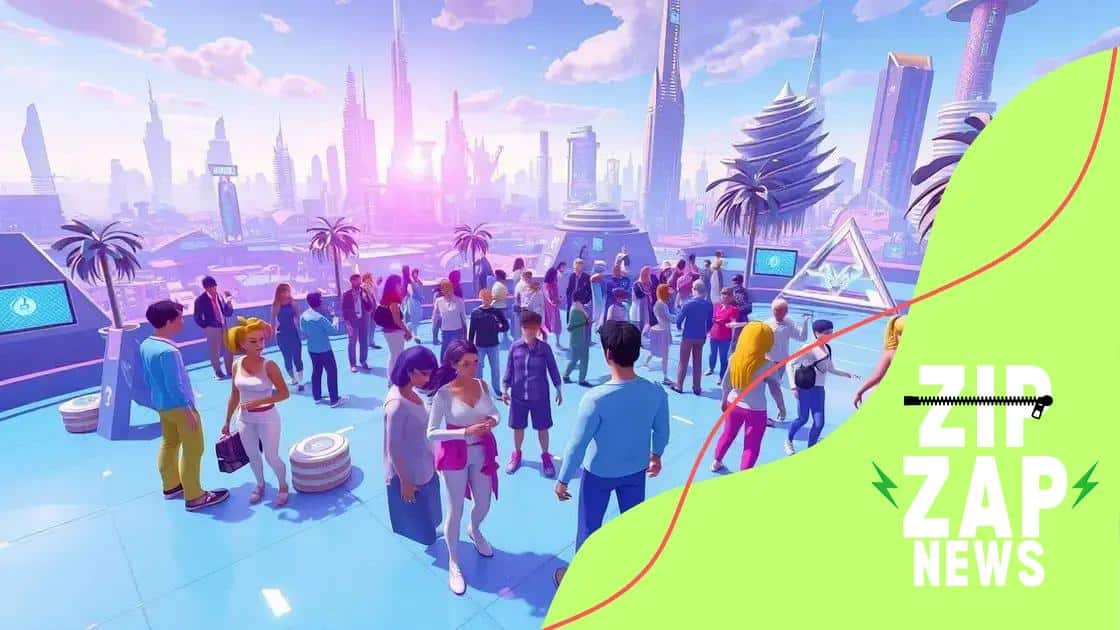The metaverse’s influence on digital communities

The metaverse’s influence on digital communities significantly enhances how users connect, interact, and build relationships through immersive environments, fostering inclusivity and collaboration among diverse users.
The metaverse’s influence on digital communities is transforming the way we socialize online. Have you ever considered how these virtual spaces might change your interactions? In this article, we’ll dive into the profound effects the metaverse has on community dynamics.
Understanding the metaverse
Understanding the metaverse is essential to grasp how this digital world is reshaping our online interactions. The metaverse is a collective virtual space where users can interact with a computer-generated environment and other users.
This exciting concept combines elements of virtual reality (VR), augmented reality (AR), and the internet. As we dive deeper, it becomes clear that the metaverse is not just a trend but a new way of connecting.
What is the metaverse?
The metaverse serves as an ecosystem that integrates different technologies to create immersive experiences. Have you ever imagined walking through a virtual mall, trying on clothes with your avatar, or attending a concert with friends from around the world? This is all possible in the metaverse.
Key characteristics of the metaverse:
- Interactivity: Users can engage with digital environments in real-time.
- Persistence: The virtual world continues to exist and evolve, even when you’re not logged in.
- User-generated content: Many users contribute to the metaverse, creating their own experiences and environments.
- Social opportunities: The metaverse fosters connections through shared experiences.
This digital realm not only changes how we play games but also how we socialize and conduct business. Imagine attending a meeting with colleagues from different countries in a virtual conference room. The possibilities are endless!
As we explore the metaverse further, it’s fascinating to see how it blurs the lines between reality and virtuality. This new digital landscape encourages innovation and creativity.
With each passing day, more people are becoming aware of the potential the metaverse holds. What do you think about this new wave of digital interaction? Are you ready to step into the metaverse?
Impact on online relationships
The impact on online relationships within the metaverse is significant and transformative. Many users experience a new way of connecting that extends beyond traditional social media platforms.
As virtual worlds evolve, we see how these spaces facilitate deeper interactions among users. People can meet in immersive environments, creating a sense of presence that enhances relationships.
How does the metaverse affect connections?
In the metaverse, individuals often feel more engaged than on standard websites. This increased engagement can lead to more meaningful conversations and friendships. The ability to customize avatars also allows users to express themselves fully.
Benefits of online relationships in the metaverse:
- Enhanced communication: Avatars can convey emotions and body language, making conversations richer.
- Diverse connections: Users can connect with people from around the globe, leading to diverse friendships.
- Shared experiences: Engaging in events, games, or projects together strengthens bonds.
- Accessible environments: The metaverse removes geographical barriers, allowing anyone to participate.
This new online landscape not only enriches friendships but also nurtures communities. People can come together over shared interests, whether it’s gaming, art, or socializing.
The metaverse encourages collaboration and teamwork, pushing users to work together in creative ways. Imagine building a virtual business or planning an event with friends from different countries.
Such interactions foster a sense of belonging, which is crucial in today’s digital age. As we embrace these new forms of connection, it’s essential to understand their impact on our daily lives and mental well-being.
Evolving digital interactions

Evolving digital interactions have drastically changed the way we communicate and connect in the modern world. With the rise of the metaverse, these interactions are becoming more immersive and engaging than ever before.
As technology advances, online communication evolves beyond simple text chats or video calls. Users can now enter virtual spaces, interact with holograms, and participate in shared experiences. This shift changes how we perceive relationships and community.
New forms of interaction
In the metaverse, users communicate not just through words, but by embodying avatars. These avatars can express emotions and body language, making interactions feel more personal. This results in a richer experience compared to traditional online communication.
Benefits of evolving interactions include:
- Enhanced emotional connection: Non-verbal cues become visible, fostering deeper understanding.
- Creative expression: Users can personalize their avatars, reflecting their personalities.
- Collaborative possibilities: People can work together in real-time, regardless of their physical location.
- Engaging environments: Interactive elements in virtual spaces keep users interested and involved.
Moreover, these evolving interactions can create a sense of presence. You can attend events, concerts, or social gatherings with users from different parts of the world in real-time. This break from geographical limitations allows for unique and creative forms of socialization.
As we adopt these new ways of interacting, it’s essential to understand their implications for our daily lives. These changes can improve our relationships and foster a sense of belonging in a digital age.
Community building in the metaverse
Community building in the metaverse plays a vital role in shaping our digital experiences. As people gather in these virtual spaces, they create connections and relationships that enrich their online lives.
In the metaverse, community building is about more than just sharing interests; it’s about forming a sense of belonging. Users can participate in events, collaborate on projects, and engage in social activities that help forge strong ties.
Key aspects of community building:
Creating a thriving community in the metaverse involves several important factors. Communities can be built around common interests or activities, providing a shared focus for members. These elements encourage users to engage actively and deepen their connections.
Essential components of a successful community:
- Inclusivity: Everyone should feel welcome and valued, regardless of their background.
- Engagement: Hosting events and interactive activities keeps community members involved.
- Collaboration: Members should be encouraged to work together, share ideas, and create content.
- Support networks: Building friendships and mentorship opportunities fosters a supportive environment.
The metaverse also allows users to express themselves more freely than in traditional online environments. Avatars can represent unique identities, promoting authenticity and connection. This expression can draw like-minded people together, strengthening community ties.
As these communities grow, they can extend beyond the virtual world. Members often create real-life friendships, attending events together or collaborating on projects outside of the metaverse. This blending of virtual and real-life interactions illustrates the power of community building.
Future trends in digital communities
Future trends in digital communities are shaping how we will connect, interact, and form relationships online. As technology continues to advance, these trends promise to enhance our experiences in the metaverse.
One key trend is the rise of decentralized platforms. These platforms give users more control over their data and interactions. As users demand greater privacy and security, decentralized environments are likely to become more popular.
Emerging technologies influence
Another significant trend involves the integration of artificial intelligence and machine learning. These technologies can personalize user experiences, making interactions more relevant and engaging. AI can help create virtual assistants that guide users through their experiences, making navigation easier.
The role of virtual reality (VR) and augmented reality (AR):
- Immersive experiences: VR and AR will allow users to engage in more realistic and interactive community activities.
- Shared virtual events: These technologies can facilitate concerts, meetings, and social gatherings in ways we have not seen before.
- Enhancing creativity: Users will have tools to create their own virtual spaces, encouraging self-expression and collaboration.
- Bridging the gap: Combining physical and virtual worlds can help connect users, leading to more dynamic interactions.
As these trends unfold, communities will likely become more inclusive and diverse. People from different backgrounds will find common ground in virtual environments, promoting understanding and collaboration.
In addition, as digital communities grow, the importance of moderation and safety will rise. Community leaders and platforms will need to implement effective measures to ensure positive interactions.
FAQ – Frequently Asked Questions about the Metaverse and Digital Communities
What is the metaverse?
The metaverse is a virtual space where users can interact with each other and with digital environments in real-time, combining aspects of virtual reality and social media.
How does the metaverse enhance community building?
The metaverse fosters connections and relationships by allowing users to interact through avatars, participate in events, and collaborate on projects, creating a strong sense of belonging.
What technologies are influencing digital interactions in the metaverse?
Technologies like artificial intelligence, virtual reality, and augmented reality are enhancing digital interactions by making them more immersive and personalized.
How can I ensure my safety in virtual communities?
To ensure safety, participate in communities that prioritize moderation, report harmful behavior, and maintain privacy settings to control your information.





